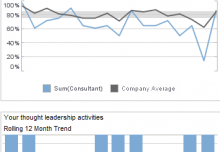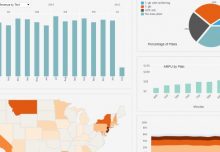Businesses always require a highly efficient and effective method of analyzing official data. Use of sophisticated software to study complex data is on the rise and business intelligence software solutions have become the greatest competitive tools for companies. It has happened because business intelligence or BI is no longer limited to a centralized group of advanced data analysts. Instead, today, innovative, user-friendly, and powerful business intelligence dashboard software similar to that offered by InetSoft allows a broad range of business users to view and analyze multi-dimensional data.
The Spread and Importance of BI Teams
With BI being critical to every industry, it has become a part of everyone’s job. However, this expansion brings new challenges that need to be tackled. The majority of BI users lack the structure, leadership, and guidance to successfully mine data. In this post, we are going to see how we can organize teams, establish guidelines, entrust data management, and show the BI team the path to success and drive innovation throughout the business.
Setting Up a Structure and Boundaries
A structure is a crucial need for every method. Therefore, to achieve BI project objective, it is necessary to establish research boundaries. It is essential to identify the best personnel from the group and define their roles and responsibilities right at the beginning. However, it all boils down to how this group is governed, thus, making it important for management structure to check their style of work.
While a big organization can work with a strict set of guidelines for their employees together with a series of command determining who initiates a project, small corporations may stick to simple face-to-face meetings to review project status, discuss near- and long-term business strategies, and address issues they have been facing, if any.
Making Domain Experts Familiar with Technicalities
InetSoft’s BI application is playing a huge role in helping operations, sales, and marketing professionals carry out their work efficiently. Though these professionals possess a deep understanding of their role in the business, their lack of experience in using such tools impedes their efficiency.
Hence, it becomes imperative for companies to pair their technical resources with business users to assist them in tackling technical aspects such as pulling the correct data set or applying the right statistical model. It is company’s decision if they want to hire consultants for this or look at their BI vendor for assistance.
Authorize Business Users to Participate in Data Management
Experts feel that many organizations are needlessly preoccupied with data preparation. Somewhere around 60-90 percent of analysts spend their time just preparing for the analysis and this obsession is attributed to the fact that businesses always look for clean and “precise data.”
Nevertheless, a way out of this situation is to have business users work in tandem with the IT team to ensure what makes the data acceptable, accurate, and correct. In fact, it should be the analyst who directs IT and not the other way around to ensure data accuracy.
Look for New Openings
Businesses that can develop administrative structure, select effective leaders, and efficiently prioritize data management often feel that their BI teams are underutilized even though they are a valuable strategic resource.
These groups of professionals are better at decision-making as compared to anyone in the company because not only do they provide better information, but they also re-define the process of questioning and action taking. Moreover, these BI teams are highly effective in applying various methods to help improve the overall performance of their business in new areas.
Wrapping Up
Have you taken any step in ensuring adequate analysis of organizational data? If not, we welcome you to evaluate business intelligence solution and see how you can arm a BI team with definite roles and responsibilities.




